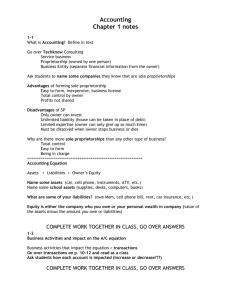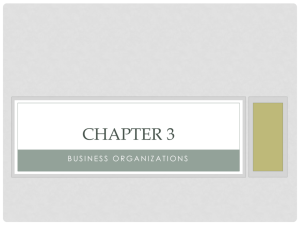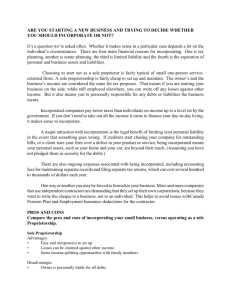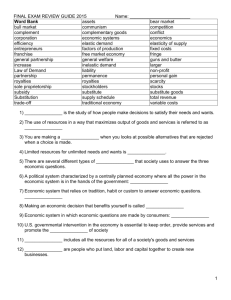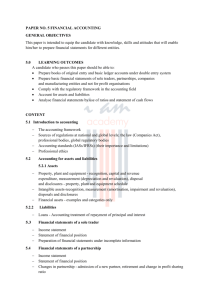Partnership Formation
advertisement
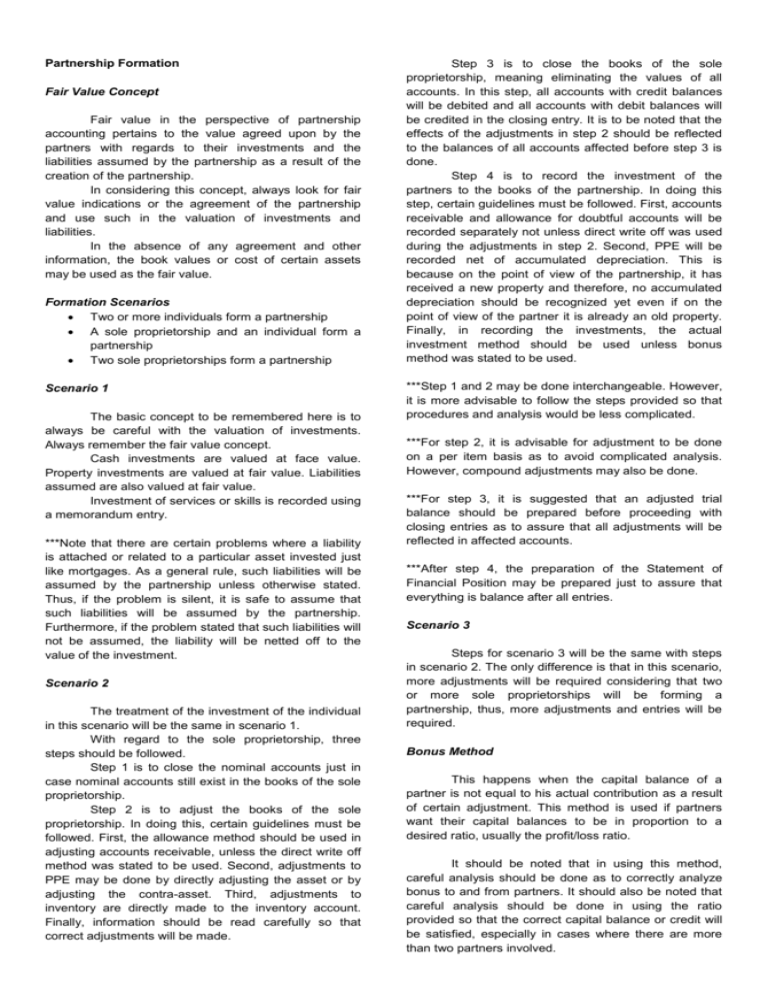
Partnership Formation Fair Value Concept Fair value in the perspective of partnership accounting pertains to the value agreed upon by the partners with regards to their investments and the liabilities assumed by the partnership as a result of the creation of the partnership. In considering this concept, always look for fair value indications or the agreement of the partnership and use such in the valuation of investments and liabilities. In the absence of any agreement and other information, the book values or cost of certain assets may be used as the fair value. Formation Scenarios Two or more individuals form a partnership A sole proprietorship and an individual form a partnership Two sole proprietorships form a partnership Scenario 1 The basic concept to be remembered here is to always be careful with the valuation of investments. Always remember the fair value concept. Cash investments are valued at face value. Property investments are valued at fair value. Liabilities assumed are also valued at fair value. Investment of services or skills is recorded using a memorandum entry. ***Note that there are certain problems where a liability is attached or related to a particular asset invested just like mortgages. As a general rule, such liabilities will be assumed by the partnership unless otherwise stated. Thus, if the problem is silent, it is safe to assume that such liabilities will be assumed by the partnership. Furthermore, if the problem stated that such liabilities will not be assumed, the liability will be netted off to the value of the investment. Scenario 2 The treatment of the investment of the individual in this scenario will be the same in scenario 1. With regard to the sole proprietorship, three steps should be followed. Step 1 is to close the nominal accounts just in case nominal accounts still exist in the books of the sole proprietorship. Step 2 is to adjust the books of the sole proprietorship. In doing this, certain guidelines must be followed. First, the allowance method should be used in adjusting accounts receivable, unless the direct write off method was stated to be used. Second, adjustments to PPE may be done by directly adjusting the asset or by adjusting the contra-asset. Third, adjustments to inventory are directly made to the inventory account. Finally, information should be read carefully so that correct adjustments will be made. Step 3 is to close the books of the sole proprietorship, meaning eliminating the values of all accounts. In this step, all accounts with credit balances will be debited and all accounts with debit balances will be credited in the closing entry. It is to be noted that the effects of the adjustments in step 2 should be reflected to the balances of all accounts affected before step 3 is done. Step 4 is to record the investment of the partners to the books of the partnership. In doing this step, certain guidelines must be followed. First, accounts receivable and allowance for doubtful accounts will be recorded separately not unless direct write off was used during the adjustments in step 2. Second, PPE will be recorded net of accumulated depreciation. This is because on the point of view of the partnership, it has received a new property and therefore, no accumulated depreciation should be recognized yet even if on the point of view of the partner it is already an old property. Finally, in recording the investments, the actual investment method should be used unless bonus method was stated to be used. ***Step 1 and 2 may be done interchangeable. However, it is more advisable to follow the steps provided so that procedures and analysis would be less complicated. ***For step 2, it is advisable for adjustment to be done on a per item basis as to avoid complicated analysis. However, compound adjustments may also be done. ***For step 3, it is suggested that an adjusted trial balance should be prepared before proceeding with closing entries as to assure that all adjustments will be reflected in affected accounts. ***After step 4, the preparation of the Statement of Financial Position may be prepared just to assure that everything is balance after all entries. Scenario 3 Steps for scenario 3 will be the same with steps in scenario 2. The only difference is that in this scenario, more adjustments will be required considering that two or more sole proprietorships will be forming a partnership, thus, more adjustments and entries will be required. Bonus Method This happens when the capital balance of a partner is not equal to his actual contribution as a result of certain adjustment. This method is used if partners want their capital balances to be in proportion to a desired ratio, usually the profit/loss ratio. It should be noted that in using this method, careful analysis should be done as to correctly analyze bonus to and from partners. It should also be noted that careful analysis should be done in using the ratio provided so that the correct capital balance or credit will be satisfied, especially in cases where there are more than two partners involved.
